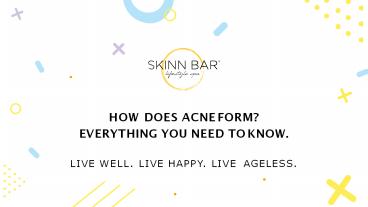How Does Acne Form? Everything You Need To Know - PowerPoint PPT Presentation
Title:
How Does Acne Form? Everything You Need To Know
Description:
Know Everything About How Does Acne Form. – PowerPoint PPT presentation
Number of Views:35
Title: How Does Acne Form? Everything You Need To Know
1
HOW DOES ACNE FORM? EVERYTHING YOU NEED TO
KNOW. LIVE WELL. LIVE HAPPY. LIVE AGELESS.
2
How Does Acne Form? Everything You Need To
Know. The one thing common in almost all kinds
of acne is that they all are the results of
various irregularities in the same gland. Read
about it in detail and how you can deal with it,
here
3
- There are several different types of acne, and
its effective treatment depends upon the type of
acne. But, one thing is similar for all that is
they are caused by some irregularities of the
pilosebaceous units - Your pilosebaceous units consist of
- A hair follicle
- A hair shaft
- Sebaceous glands
4
Let us see the different types of acne,
depending on the issue that happens to the
pilosebaceous units.
5
Ordinary pimple (Inflammatory papule)
The ordinary, in?amed, red bump that appears on
your face when you think of acne is known as a
regular pimple. Experts call this regular red
pimple in?ammatory papule.
6
Why do they happen?
A hair follicle contains sebum secreted by the
sebaceous gland. And with it dirt and dead skin
cells also get trapped in the pores. Resulting in
the blockage and allowing bacteria P.acnes to
grow in the area, causing in?ammation and
outbreak.
7
What to do?
- There are two ways to approach this problem
- Try and reduce the stickiness of the cells so
that there is no buildup in the hair canal. - Solution Use over-the-counter salicylic acid and
prescribed tretinoin products to reduce the
stickiness.
8
Continued
- Deal directly with the bacteria
- Solution Use over-the-counter benzoyl peoxide
or topical antibiotic creams that kill P. acnes.
The doctor may prescribe oral antibiotics if you
have too many pimples.
9
Pustule
They are the same as that of a pimple. But the
only difference that sets them apart from pimple
is they contain the white blood cells, too.
10
Why do they happen?
The white cells that are present connect with
the P.acnes to form a greater buildup within the
pimple. Excess white cells lead to pus, which is
the first sign of pustules.
11
What to do?
The treatment involved is the same as that of an
ordinary pimple.
12
Early acne (Microcomedone)
The terrible amongst the types of acne which
happens in the early youth. And hormones do play
a role in this type of acne formation.
13
Why do they happen?
The acne process is similar to the ordinary
pimples but there are some differences. The skin
cells that shed are known as corneocytes.
Usually not sticky, but sometimes they become
sticky and accumulate, which results in the
growth of bacteria p.acnes that feed on the
sebum. And as excess sebum attracts excess
bacteria, the entire follicle gets inflamed.
14
What to do?
- Use tretinoin or salicylic acid lotions to
reduce the stickiness of the cells. - Also, use benzoyl peroxide to arrest the growth
of P.acnes.
15
Cyst or Nodule
The most painful and aesthetically problematic
type of acne involves scarring and even oozing
of blood. Impossible to cover up, they can get
worse if not handled properly.
16
Why do they happen?
Like early acne, there is an excessive buildup
of corneocytes and the sebum. This massive
buildup, when spilled into surrounding tissues,
creates scars and even a bit of bleeding. A
painful cyst gets formed after this.
17
What to do?
- Do not go for the over-the-counter products as
it is too late for it at this stage. - Along with topical and oral antibiotics, use
products that reduce the stickiness of the
cells. - Some doctors may prescribe Accutane along with
regular monitoring to check for any ad verse
effects.
18
Whiteheads and Blackheads
The blackheads are present in the open pore
while the whiteheads are in the closed pores.
19
Why do they happen?
The buildup of sebaceous material results in the
formation of whiteheads and blackheads. What
makes them different is the consistency of this
type of content, it becomes firm and thick. If
the pore remains open, it is a blackhead, easily
classified by the color. Whereas, the closed
pores will form a whitehead.
20
What to do?
- Using salicylic acid based lotions prevents
stickiness as well as the buildup from being
firm and consistent. - Use benzoyl peroxide that will help to kill the
bacteria and stop the infection. - Use over-the-counter options like trenoin-based
products and topical antibiotics.
21
Taking care with regular facial hygiene, and
proper skincare routines will help you maintain
beautiful and clean skin that is acne-free.
22
- Consult with our expert dermatologists and find
a treatment to assist you through your clear
skin journey.
Book an appointment today!
w w w .skinnba r. c om
23
LIVE WELL. LIVE HAPPY. LIVE AGELESS.































